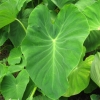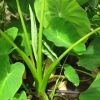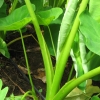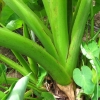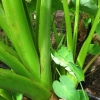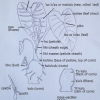Use As Food
A commercial poi taro in certain areas on O‘ahu, making a good quality poi of grayish color. The young leaves are comparatively nonacrid (a flavor that is not sharp or bitter) and are used extensively for lū‘au. Formerly, Hawaiians used this taro as an offering to the gods, the lū‘au being highly prized by the kahuna. It was also used widely for medicinal purposes. Ku‘i when it is hot, it will pound smoothly. Ku‘i when it is cool and the kalo gets lumpy.
Distribution
Quite common throughout the islands, under both wetland and māla (upland) culture.
General Characteristics
Medium in height, erect, stocky, maturing within 9 to 12 months, producing from 10 to 15 ‘ohā; distinguished by the light green Hā (Petiole) and narrowly egg-shaped (ovate) Lau or lū‘au (Leaf blade).
Ha (Petiole)
65 to 90 cm. long, light green with an indistinct greenish lihi (stem edge), white at kōhina (base).
Lau or Lu'au(Leaf Blade)
45 to 60 cm. long, 35 to 50 cm. wide, 35 to 45 cm. from tip to base of sinus (māwae), narrowly egg-shaped (ovate), medium green; piko light yellowish-green; veins rather conspicuons round leaf section (lobes) obtuse with wide lihi māhae (sinus).
'I'o kalo (Corm)
Flesh white with yellowish fibers; skin white; roots conspicuously white.
Pua (Flower)
Hā (peduncle) light green; flower cover (spathe) 26 to 37 cm. long, the lower tubular portion 4 to 5 cm. long, light green with faint tinge of purple at kōhina (base), rather loosely rolled, the upper portion deep yellow, open near constriction (skinny part of flower) and loosely rolled above; spadix (spike of flower) 8 to 11 cm. long, the sterile appendage (tip of flower's spike) 9 to 14 mm. long, clearly constricted from flower sex organ (staminate) portion.
Remarks
Haokea has a reputation as a medicinal kalo. According to Mark Stride of Luluku, friends who eat Haokea say it settles their stomach. He first found this variety in the wild rainforest as Aweoweo variety. After four generations of growing in a lo'i, the kalo transformed into Haokea; the corm increased in size. With each generation the calcium oxalate crystals decreased when cooked. Aweoweo sent out runners to grow new kalo, but as Haokea the new keiki grow as oha.

